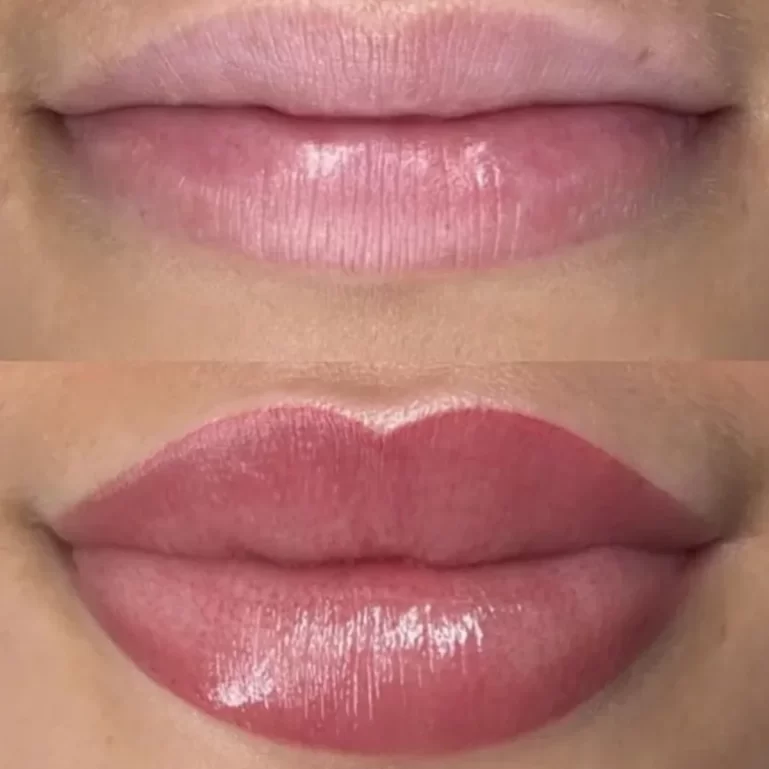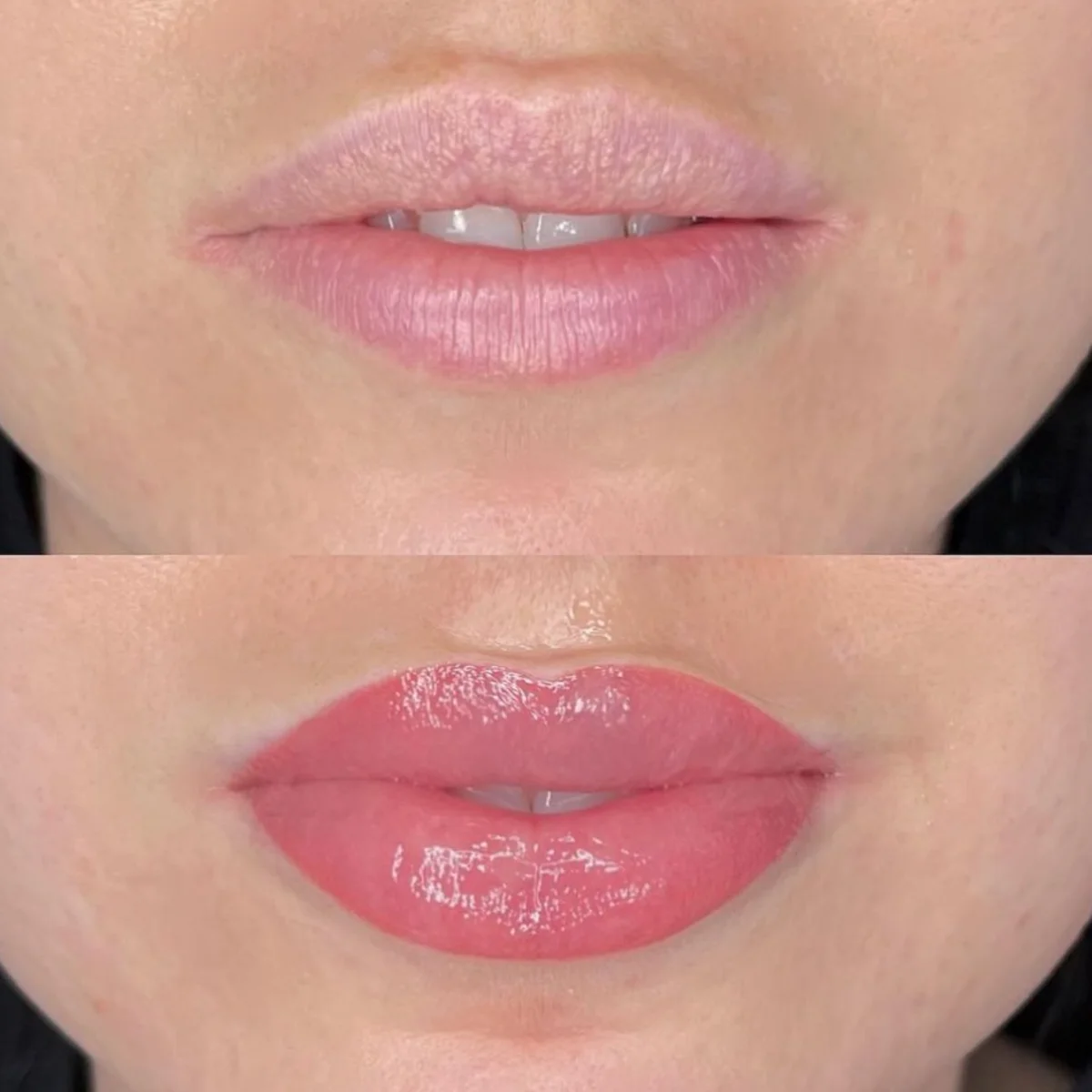
Lip blush tattoo
A lip blush tattoo is a semi-permanent cosmetic procedure that uses colour ink to enhance the appearance of the lips by adding colour and defining the lip line, resulting in a subtle and natural look.

What is a lip tattoo?
Lip tattooing, or lip tinting or blush, involves implanting pigment into the lips. This is done to enhance their colour and shape. The procedure can add fullness and definition and improve facial symmetry. Lip tattooing is typically done with a specialised tattooing machine and can take one or two hours. Results can last for years, with touch-up sessions possibly needed. Common side effects include swelling, redness, and tenderness, which usually disappear in a few days. Choosing a traitor ned professional for the procedure is essential for best results and minimising risks.
Lip tattooing features
A lip blush tattoo can enhance the appearance of your lips, giving them a fuller, more seductive look without the need for filler injections. Procedures at places like the HD Beauty Permanent Makeup Academy are non-invasive and cost-effective. A typical tattooing session uses a medical-grade aesthetic to minimise discomfort and ensure a comfortable experience.
After the procedure, you will have sexier and fuller lips. Cosmetic lip tattoos can fix issues like lip unevenness, sun damage, or thin lips. The procedure enhances beauty, convenience, and confidence. Lip tattoos are non-invasive for those who want to avoid traditional lip correction procedures or have allergies.
A lip colour tattoo is a semi-permanent procedure that uses a special handheld blading pen to implant colour into the skin. The pen uses tiny, fine-point needles to create disposable blades that leave ink or pigment deposits in the skin. While similar to a tattoo, the ink used for lip tattoos is less concentrated, making them semi-permanent.
These factors combine to enhance the appearance of the lips.
Which colour is suitable for each person?
When getting a lip tattoo, it is essential to choose the colour with the tattoo artist and avoid shades that may become outdated.
It is not advisable to follow seasonal or trending shades.
During consultations, we typically consider clients’ preferred shades regarding skin tone, hair colour, and daily makeup routine. It is essential to choose natural shades carefully.
Potential risks
Before undergoing any procedure, evaluating potential risks and side effects is crucial. Following the treatment, it is normal for the lips to appear heavily pigmented for two to three days, but the colour will eventually soften as the outer layer of skin sheds.
Care and maintenance following a lip tattoo
Following proper aftercare instructions for a lip tattoo is essential for optimal results and to reduce the risk of complications. Some general tips include avoiding touching the tattooed area for at least 24 hours, gently washing it with warm water and mild soap, and moisturising it with petroleum jelly or tattoo aftercare cream.

After getting a tattoo, it’s essential to follow these guidelines: refrain from exposing the tattooed area to water, avoid applying makeup or other products, refrain from picking at scabs, avoid sun exposure, and avoid alcohol and caffeine. Additionally, avoiding activities potentially harming the tattooed area is best until it fully recovers. Discuss specific aftercare instructions with your tattoo artist for optimal results.
Lip tattoo healing time varies
After a permanent tattooing procedure on the lips, it is common for them to be stressed and damaged by the needle as the pigment is injected under the skin. Healing time is necessary but should be assisted based on instructions provided by the beautician.
After a lip tattoo, the healing process typically lasts a month, with rehabilitation divided into two distinct phases.
Women must take care of the result during the first seven to eight days after getting a tattoo. However, individuals with a fast metabolism may experience a shorter healing period. The skin regenerates naturally during the remaining three weeks of the healing process. Follow the recommendations during the appointment for optimal results.
Both parts of the recovery process are crucial for the skin during this delicate time. The skin, located near the mucous membrane of the mouth, has a thin surface that results in a longer healing time.
Improper care of a tattoo can negatively impact the final result
Panthenol is commonly used as a healing ointment with regenerative solid properties. An antiseptic is recommended before applying panthenol. A standard antiseptic or miramistin can be used for this purpose.
Applying a cream to the lips after a tattoo procedure, particularly during the first week, is essential to prevent dryness. A suitable product, such as petroleum jelly, should be consistently used to moisten the lips.
It is recommended to apply a thick layer of ointment to the lips every hour from the first to the third day and five times a day after the appearance of a crust. If the crust is damaged, apply an antiseptic followed by a healing cream until a new protective layer forms on the lip.
What is the duration of a lip tattoo?
Most lip tattoos typically last up to 2 years, but in reality, the effect can last 3-5 years depending on your skin’s natural cycle, individual skin type, and colour.
The duration of a lip tattoo can vary based on factors like pigment quality, artist skill, skin type, and lifestyle. A lip tattoo can typically last several years before fading or needing touch-ups. Some may find their lip tattoo fades faster, while others may have longer-lasting results. Touch-up sessions every one to two years are recommended to maintain the desired effect. Discuss your expectations and concerns about duration with your tattoo artist before the procedure.